Ramesh Singh Summary: Industry & Infrastructure- 3 | Indian Economy for UPSC CSE PDF Download
Performance of CPSEs
The Central Public Sector Enterprises (CPSEs) have undergone a significant change in the government's approach since November 2020. Initially, the government focused on import substitution and self-sufficiency, following the Mahalanobis Plan in 1956. However, due to inefficiencies causing low productivity, high costs, and financial strain, the government started privatizing Public Sector Undertakings (PSUs) after 1991.
 Central Public Sector Enterprises (CPSEs)
Central Public Sector Enterprises (CPSEs)
Under the "Atmanirbhar Bharat" mission, the government aims to revamp and streamline CPSEs. The proposal involves reducing the government's involvement in commercial activities, particularly in "non-strategic sectors." This may include privatization, mergers, or bringing these enterprises under holding companies. The goal is to foster healthy competition in various sectors, allowing the government to focus on essential or "strategic sectors."

To ensure the success of this initiative, the Economic Survey 2020-21 suggests several reforms:
Revamping Boards and Structure: Restructuring the leadership and organizational setup of CPSEs.
Enhancing Operational Autonomy: Granting more independence to the Boards, along with enforcing strong corporate governance norms.
Listing on Stock Exchange: Encouraging CPSEs to be listed on the stock exchange for greater transparency in their operations.
Apart from privatization and streamlining, the government has also taken additional steps, such as revamping the "performance monitoring system" to make it more objective and forward-looking. This system now relies on sectoral indices and benchmarks. Additionally, there is a focus on timely closure of underperforming enterprises and the disposal of their assets. All these measures aim to improve efficiency, competitiveness, and overall performance of CPSEs in line with the government's strategic goals.
Industry Sectors
Steel
Steel is vital for industries, urban development, and infrastructure in India, making it the world's second-largest producer and consumer of steel after China. Despite its significant role, per capita steel consumption in India is lower than the global average.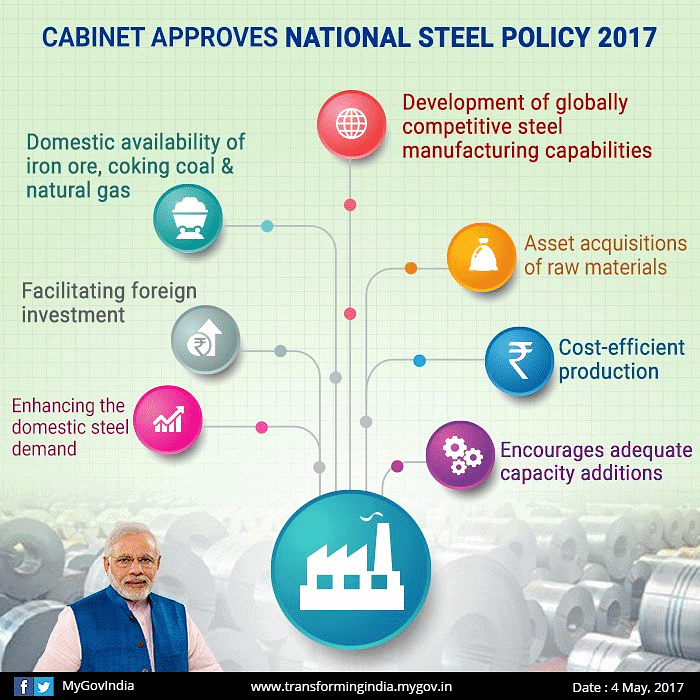 National Steel Policy
National Steel Policy
- The National Steel Policy 2017 aims to boost production capacity and global competitiveness, targeting 300 million tonnes of crude steel and 230 million tonnes of finished steel by 2030-31, with a per capita consumption goal of 158 kg.
- Under the Atmanirbhar Abhivan, the government has implemented measures to enhance domestic steel production, including incentives for 'Specialty Steel' under the Production Linked Incentive (PLI) scheme.
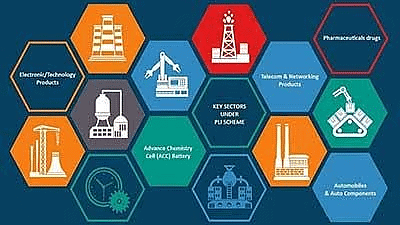 PLI Scheme
PLI Scheme - Initiatives such as fair pricing for steel supplied to engineering export organizations and preference for domestically produced iron and steel in government procurement have been introduced.
- The Economic Survey 2022-23 highlights robust performance in the steel sector, with increased production and consumption compared to the last four years.
- The Production Linked Incentive (PLI) scheme is expected to contribute to a 26 million tonne increase in steel production, and exports have risen by 20% compared to pre-pandemic levels in 2019-20.
- The government's focus on infrastructure projects, along with higher capital expenditures, is driving the growth of the steel sector.
- However, challenges in the global economy may impact steel exports, despite positive domestic trends.
Coal
India has a goal to achieve zero emissions by 2070, but right now, a large part of its energy, about 55%, comes from coal. Coal is essential for various industries like iron and steel, cement, paper, and brick kilns.
To balance the need for energy and environmental concerns, the government has taken some steps:
Clean Coal Initiatives: By early 2023, they planted 143 million trees on about 58,350 hectares of land. This created a carbon sink, absorbing around 3.1 lakh tonnes of CO2 each year. The plan is to plant 50 million more trees on an additional 20,000 hectares by 2030.
Coal Bed Methane (CBM) Projects: There are plans for two CBM projects, which could significantly reduce the carbon footprint.
Surface Coal Gasification Projects: They aim to set up projects that use 100 million tonnes of coal with a relatively lower carbon footprint by 2030.
First Mile Connectivity Projects: These involve transporting coal from mines to dispatch points efficiently.
Amendment in Act and Rules
These measures are designed to address the environmental impact of coal use while acknowledging the country's heavy reliance on it for energy needs.
The government made changes to laws and rules to address coal-related issues:
Mineral Laws (Amendment) Act, 2020: In March 2020, amendments were made to the Provisions Act, 2015, specifically affecting several special coal mines.
 Mineral Laws (Amendment) Act, 2020
Mineral Laws (Amendment) Act, 2020Coal Block Allocation: By early 2022, 28 coal blocks were auctioned to the private sector, and there were plans to auction 88 more.
Commercial Mining Auctions: In June 2020, 38 coal mines were auctioned for commercial mining. Out of these, 19 were successfully auctioned, marking a 50% success rate, which is an improvement from the past.
Shortage of 2022-23
In 2022-23, there was a shortage of coal due to increased economic activity and heat waves from March to mid-May. This led to a higher demand for power. Also, international coal prices rose, causing a significant reduction in coal imports—from 69 million tonnes in 2019-20 to 27 million tonnes in 2021-22. The domestic coal production couldn't match the rising demand, causing a decrease in coal stock with power plants.
To address this:
Import of Coal: Power generators were asked to import 10% of their coal requirements (up from 4%). Penalties were imposed, including the reduction of domestic coal entitlements if power plants failed to import coal.
Full Capacity Operation: Imported coal-based plants were instructed to run at full capacity, and their increased operational costs were assured to be compensated.
Tolling: States were allowed to transfer their allotted coal to private generators near mines instead of transporting it far away. This move eased the strain on the availability of railway resources.
Additional Capital: Additional working capital was made available through various sources, including Rural Electrification Corporation, Power Finance Corporation, and commercial banks.
Pharmaceuticals Industry
The Indian pharmaceutical industry is significant globally, with a domestic market estimated at $41 billion in 2021, expected to grow to $65 billion by 2024 and potentially reach $130 billion by 2030. India holds the third position globally in pharmaceutical production by volume and fourth by value. Indian Pharmaceutical industry & its contribution
Indian Pharmaceutical industry & its contribution
Key points from the Economic Survey 2022-23 are as follows:
Global Presence: India is the largest provider of generic medicines globally, contributing 20% of the global supply by volume. It is also a leading vaccine manufacturer with a 60% market share globally. In 2020-21, pharmaceutical exports grew by 24%, driven by the demand for critical drugs and supplies during the Covid-19 pandemic.
Export Performance: Despite global trade disruptions and a decline in demand for Covid-19-related treatments, pharmaceutical exports showed resilience with a growth rate of 22% in 2021-22 (April-October).
Foreign Direct Investment (FDI):
 Foreign Direct Investment (FDI) pros & consCumulative FDI in the pharmaceutical sector crossed the $20 billion mark in September 2022, marking a four-fold increase over five years. This growth is attributed to investor-friendly policies and a positive industry outlook.
Foreign Direct Investment (FDI) pros & consCumulative FDI in the pharmaceutical sector crossed the $20 billion mark in September 2022, marking a four-fold increase over five years. This growth is attributed to investor-friendly policies and a positive industry outlook.
To enhance the infrastructure of the pharmaceutical sector, the government introduced the Strengthening the Pharmaceutical Industry (SPI) scheme in March 2022 for five years (2021-26). The objectives of this scheme include:
Strengthening Infrastructure: Providing financial assistance to pharmaceutical clusters to create common facilities and improve existing infrastructure.
Support for MSMEs: Upgrading production facilities of Micro, Small, and Medium Enterprises (MSMEs) to meet national and international regulatory standards by offering interest subvention or capital subsidy on their capital loans.
Promoting Knowledge and Awareness: Undertaking studies, building databases, and fostering collaboration between industry, academia, and policymakers to share knowledge and experiences, thereby promoting awareness about the pharmaceutical and medical devices industry.
Automobile Industry
The automobile sector is crucial for India's economic growth. In December 2022, India became the 3rd largest automobile market globally, surpassing Japan and Germany. In 2021, India topped in the manufacturing of two-wheelers and three-wheelers and ranked fourth in passenger cars. According to the Economic Survey 2022-23, the sector contributes 7.1% to the overall GDP and 49% to the manufacturing GDP, providing employment for 3.7 crore people as of 2021.
The automotive industry is expected to play a vital role in the shift towards green energy.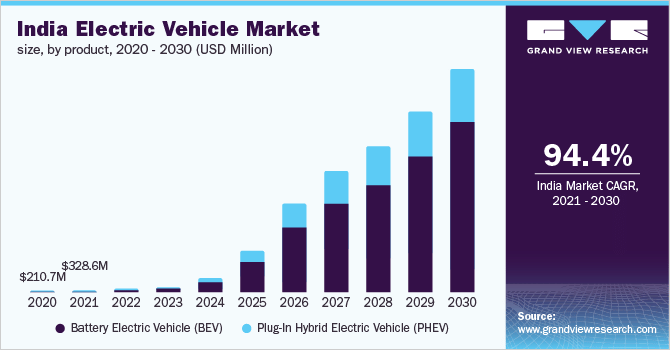
The domestic electric vehicles (EV) market is projected to grow at a rate of 49% between 2022 and 2030, reaching one crore unit annual sales by 2030. This growth is anticipated to create 5 crore direct and indirect jobs by 2030. To support this development, the government has taken various steps.
However, the automotive industry faces challenges, including:
Higher Borrowing Costs: The cost of borrowing money for businesses in the industry is high, impacting their operations.
Global Demand Downturn: There is a temporary decrease in global demand, affecting the industry in the short term.
Impact of Insurance Premium Increase: An increase in third-party vehicle insurance premiums has raised the overall insurance cost by about 10-11%, particularly affecting two-wheelers. Consequently, the two-wheeler segment experienced its lowest sales in the last ten years.
Shipbuilding Industry
Shipbuilding is a strategically important industry crucial for energy security, national defense, and heavy engineering. It significantly impacts various industries and services, creating a collaborative production ecosystem with strong links to ancillary industries like steel and engineering equipment.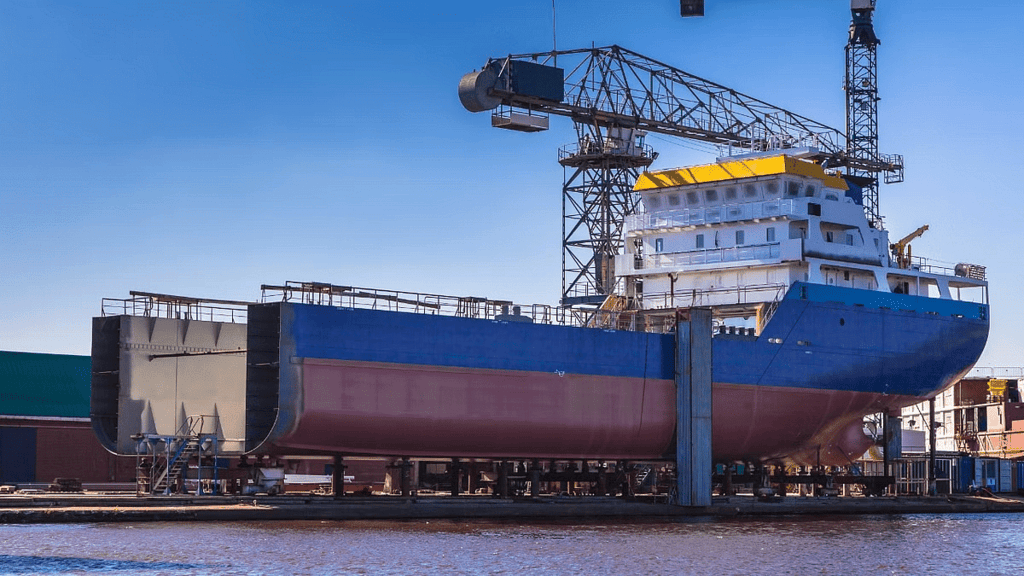 India plans incentives to improve shipbuilding industry
India plans incentives to improve shipbuilding industry
The Economic Survey 2022-23 highlights the following key contributions:
Collaborative Production Ecosystem: Shipbuilding has strong links with ancillary industries, fostering collaboration and creating opportunities for smaller businesses. Around 65% of value addition comes from manufacturers of shipboard materials, equipment, and systems.
Economic Impact: Shipbuilding has a high employment multiplier, generating mass employment in remote, coastal, and rural areas. This helps absorb labor migrating from agriculture to manufacturing facilities.
Investment Multiplier: Shipbuilding has a significant impact on the economy with an investment multiplier of around 1.82, surpassing many manufacturing activities.
Contribution to Indian Economy: A study by the Indian Navy indicates that approximately 75% of the total project cost for constructing warships is reinvested in the Indian economy.
Reducing Current Account Deficit (CAD): A thriving indigenous shipping and shipbuilding industry can help reduce freight bills and foreign exchange outgo, contributing to a reduction in the current account deficit (CAD).

Textile Industry
The textile and apparel industry is a key player in India's social and economic development, contributing 2% to the GDP, 10% to manufacturing GVA and providing employment to around 10.5 crore people, especially women, making it the second-largest employment generator after agriculture.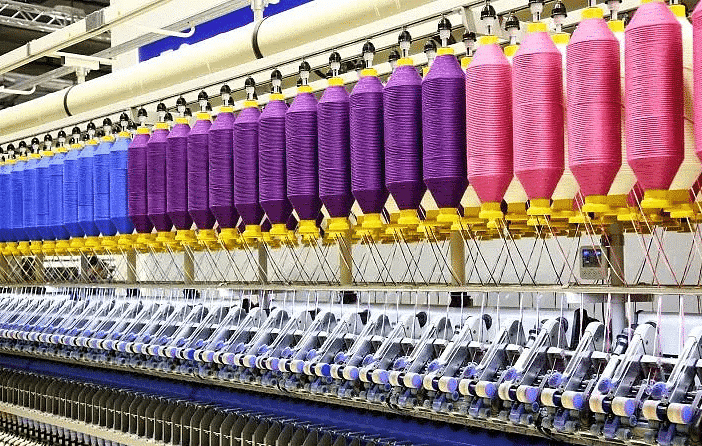 Textile Sector in IndiaAs the sixth-largest global exporter of textile and apparel products, India is renowned for items like cotton yarn, fashion garments, and handmade carpets, enhancing its image as an industrial powerhouse. Despite its significance, the industry faces challenges impacting its overall performance.
Textile Sector in IndiaAs the sixth-largest global exporter of textile and apparel products, India is renowned for items like cotton yarn, fashion garments, and handmade carpets, enhancing its image as an industrial powerhouse. Despite its significance, the industry faces challenges impacting its overall performance.
To bolster the sector, the government has implemented vital schemes:
ATUFS (Amended Technology Upgradation Fund Scheme): Aiming to modernize and upgrade technology in the textile industry.

SITP (Scheme for Integrated Textiles Park): Providing world-class infrastructure facilities, with 23 out of 56 textile parks completed by April 2021.
SAMARTH (Scheme for Capacity Building in Textiles Sector): A flagship scheme focused on skill development, targeting 10 lakh youth in the entire textiles value chain.
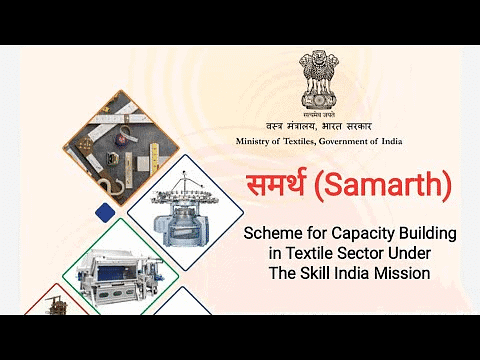 SAMARTH (Scheme for Capacity Building in Textiles Sector)
SAMARTH (Scheme for Capacity Building in Textiles Sector)MITRA (PM Mega Integrated Textiles Region and Apparel Park): Launched under AtmaNirbhar Bharat to enhance sector competitiveness, aiming for seven parks under PPP mode, covering the entire value chain from farm to fashion.
The MITRA scheme aims to develop large-scale, modern industrial infrastructure, reducing logistics costs, attracting investments, and boosting employment generation in the textile industry.
PLI Scheme
To boost domestic manufacturing and reduce import bills, the Government introduced a Production-Linked Incentive (PLI) scheme in March 2020. Under this initiative, companies receive incentives for increased sales over the next 5 years. As of April 2023, 14 sectors, have been included in the scheme, with a total allocation of around ₹2,02,325 crores.
The sectors covered are:
- Mobile Manufacturing
- Electronic Components and Specified Electronic/Technology Products
- Critical Key Starting Materials/Drug Intermediaries and Active Pharmaceutical Ingredients
- Manufacturing of Medical Devices
- Advanced Chemistry Cell (ACC) Battery
- Automobiles and Auto Components
- Pharmaceutical Drugs
- Telecom and Networking Products
- Textile Products: MMF segment and technical textiles
- Food Products
- High-Efficiency Solar PV Modules
- White Goods (ACs and LED)
- Specialty Steel
- Drone and Drone Components
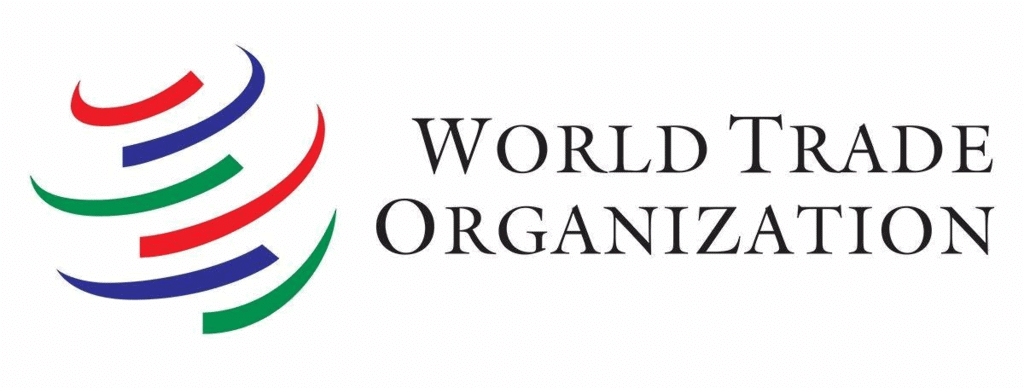 These sectors, being highly capital-intensive, offer long-term benefits, and the PLI scheme serves as a way to promote investments in them. Notably, the scheme is designed to align with India's commitments to the World Trade Organization (WTO), ensuring it is non-discriminatory and neutral concerning both domestic sales and exports.
These sectors, being highly capital-intensive, offer long-term benefits, and the PLI scheme serves as a way to promote investments in them. Notably, the scheme is designed to align with India's commitments to the World Trade Organization (WTO), ensuring it is non-discriminatory and neutral concerning both domestic sales and exports.
Incentives
Incentives Under PLI Scheme are as follows :
- Eligibility Criteria:
- Companies qualify for incentives based on their production turnover and investment expenditures.
- Incentives are a percentage of the production turnover exceeding a specified minimum floor value.
- Types of Incentives:
- Given in the form of sops and bonuses.
- Calculated based on production turnover and eligible investment expenditures.
- Exclusions: Investments in land and buildings for the project are not considered for incentives.
- Scope of PLI Scheme: Encompasses 14 key sectors, including Mobile Manufacturing, Pharmaceuticals, Textile Products, Automobiles, and more.
- Strategic Objectives:
- Enhance global competitiveness of Indian manufacturers.
- Attract investments in cutting-edge technology and core competencies.
- Ensure operational efficiency and create economies of scale.
- Integrate India into the global value chain.
- Impact on MSMEs:
- Benefits the MSME ecosystem by creating a new supplier base.
 MSME ecosystem
MSME ecosystem - Ancillary units in the MSME sector are crucial for supporting anchor units in each sector.
- Benefits the MSME ecosystem by creating a new supplier base.
- Alignment with Make in India 2.0: Combined with Make in India 2.0, the scheme has the potential to boost India's annual manufacturing capital expenditure by 15 to 20 percent from the fiscal year 2022-23.
- Economic Survey Findings: According to the Economic Survey 2022-23, the scheme is expected to contribute significantly to the growth of India's manufacturing sector.
Industry 4.0
Industry 4.0, the fourth industrial revolution, is marked by technologies like cloud computing, IoT, machine learning, and artificial intelligence transforming manufacturing processes.
Adoption of these technologies in Indian manufacturing is underway, with a growing enabling environment. Industry 4.0 technologies
Industry 4.0 technologies
Government Policy Steps:
- SAMARTH (Smart Advanced Manufacturing and Rapid Transformation Hubs):
- Launched under the Ministry of Heavy Industries and Public Enterprises.
- Aims to encourage technological solutions in manufacturing units through awareness programs and demonstrations.
- Centre for Fourth Industrial Revolution:
- Established in 2018 to develop policy frameworks for emerging technologies.
- SAMARTH (Smart Advanced Manufacturing and Rapid Transformation Hubs):
Focus on Innovation:
- Government efforts in fostering innovation include incubation, funding, industry-academia partnership, and mentorship.
- Strengthening the Intellectual Property Rights (IPR) regime by modernizing the IP office and reducing legal compliances.
 Intellectual Property Rights (IPR)
Intellectual Property Rights (IPR) - Significant results with a 46 percent growth in domestic patent filings from 2016-2021, signaling India's shift toward a knowledge-based economy.
Global Innovation Index (GII):
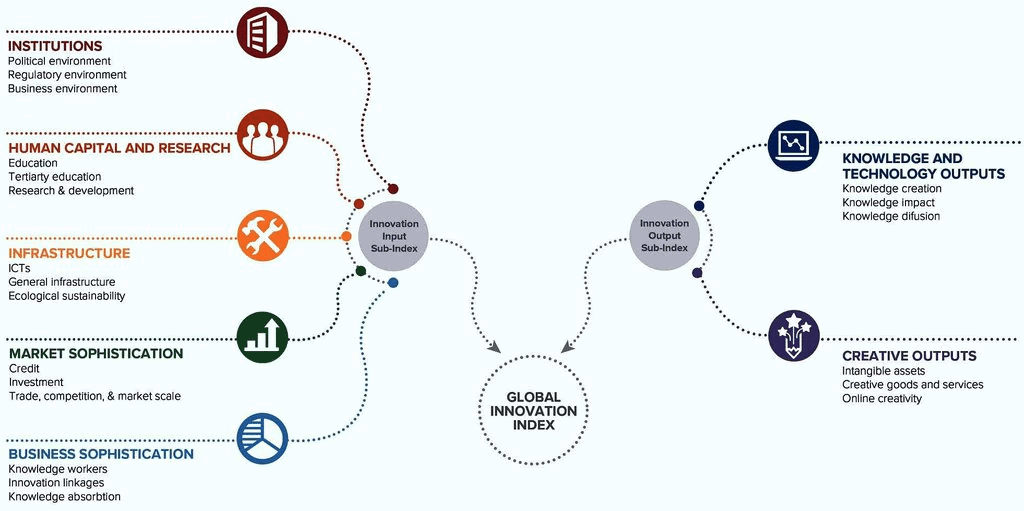 Global Innovation Index (GII)
Global Innovation Index (GII)- India entered the top 40 innovating countries for the first time in 2022, improving its rank from 81st in 2015 to 40th in 2022.
- India became the most innovative nation in the lower middle-income group, surpassing Vietnam and leading the Central and Southern Asia region.
GII Ranking Criteria:
- GII ranks countries based on innovation performance with around 80 indicators, including political environment, education, infrastructure, and knowledge creation.
Government's Achievements:
- Government measures have paid off, reflecting in India's improved innovation ranking and transition towards a knowledge-based economy.
- The Global Innovation Index (GII) 2022 report acknowledges India's progress and innovation leadership in its category.
Covid-19 and Industrial Reforms
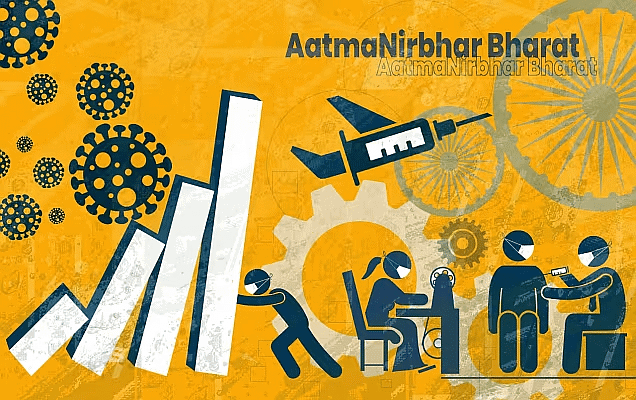
Key Industrial Reforms Under Armanirbhar Bharat Abhiyan in various sectors :
Defence:
- Banned import of some weapons to promote indigenization.
- Provision of a separate budget for defense capital procurement.
- Raised FDI limit in defense manufacturing under the automatic route to 74% (from 49%).
- Corporatization and listing of the Ordnance Factory Board (OFB) on the stock market for autonomy, efficiency, and accountability.
Space:
- Encouragement of private participation in space activities.
- Private players are allowed to use ISRO facilities and participate in future projects.
 Indian Space Research Organisation (ISRO)
Indian Space Research Organisation (ISRO) - Relaxation of geospatial data policy for wider availability to technology entrepreneurs.
Aviation:
- Auctioning of 6 more airports on PPP mode and inviting private investment in 12 more airports.
- Eased airspace restrictions for more efficient flying.
- Rationalization of MRO (maintenance, repair, and operations) tax structure to make India an MRO hub.
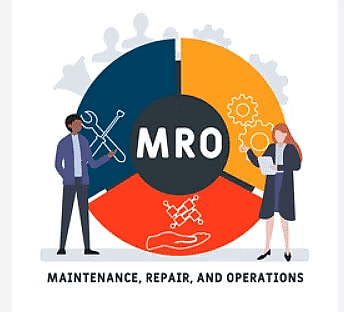 MRO (maintenance, repair, and operations)
MRO (maintenance, repair, and operations)
Minerals:
- Removal of the government monopoly on coal, and introducing of commercial mining based on revenue sharing.
- Allowance for private bidding for coal blocks and exploration activities.
Power:
- Privatization of power utilities and distribution companies in Union Territories based on a new tariff policy.
- Establishment of Atomic Research and Medical Isotope production units to enhance nuclear capabilities.
 Production of medical Isotopes
Production of medical Isotopes
Social Infrastructure:
- Boosting private investment in social infrastructure for enhanced viability.
- Increased funding under the Central Vista project by 1030%, compared to other sectors.
- Involvement of private players in social infrastructure projects.
 Central Vista project
Central Vista project
Power
The power sector in India has undergone significant changes in both demand (universal electrification) and supply (green energy adoption) over the past few decades.
Installed Capacity:
- Total Installed Capacity: The total installed capacity has reached 3,73,436 MW by late 2020.
- Diverse Sources: This includes 231,321 MW of thermal, 45,699 MW of hydro, 6,780 MW of nuclear, and 89,636 MW of renewables and other sources.
Energy Deficit: The government reports a noticeable decline in energy deficit, attributed to improved energy efficiency and reduced energy intensity.
Installed Power Capacity: Growth in Installed Capacity: The total installed power capacity for utilities and captive power plants was 482.2 GW by March 2022, showing a 0.7% increase from the previous year.
Energy Sources:
- Thermal Dominance: Thermal sources constitute the largest share (59.1%) of the installed capacity in utilities.
- Renewable Growth: Renewable energy resources contribute 27.5%, and hydro accounts for 1.7% of the total installed capacity.
Government Initiatives:
- Integrated Power Development Scheme (IPDS): Launched in 2014, IPDS aims to ensure quality and reliable 24x7 power supply in urban areas.
 Integrated Power Development Scheme (IPDS)
Integrated Power Development Scheme (IPDS) - Rural Electrification Milestones:
- Achieved 100% village electrification under the Deen Dayal Upadhyaya Gram Jyoti Yojana.
- Accomplished universal household electrification under Saubhagya (Pradhan Mantri Sahaj Bijli Har Ghar Yojana) by September 2021.
 Pradhan Mantri Sahaj Bijli Har Ghar Yojana
Pradhan Mantri Sahaj Bijli Har Ghar Yojana
- Integrated Power Development Scheme (IPDS): Launched in 2014, IPDS aims to ensure quality and reliable 24x7 power supply in urban areas.
Electricity Transmission and Distribution(T&D) in India
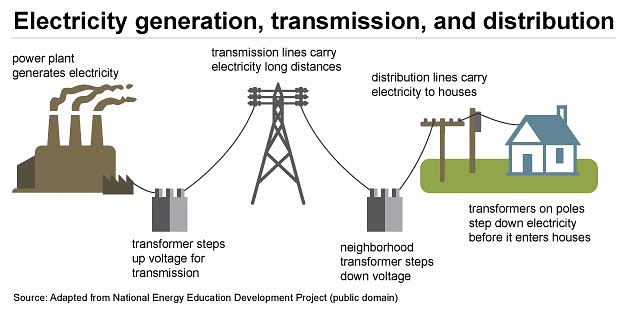
T&D Losses:
- Declining Trend: T&D losses in India have been decreasing since 2001-02, but they remain substantial.
- Latest Data (2019-20): T&D losses were at 20.46%, a notable improvement from the 32.86% in 2001-02.
- Global Comparison:
- India's T&D losses (21.5%) are higher than peer countries like China (6%), South Africa (10%), Russia (13%), and Brazil (17.5%).
- The global average for T&D losses is around 8.5%, with South Korea being the best at 3.6%.
Importance of Addressing T&D Losses:
- Impact on National Priorities: Improving DISCOMs' performance is crucial for achieving goals like 100% village electrification, 24x7 power supply, and promoting clean energy.
- Economic Impact: Power outages can negatively affect national initiatives such as "Make in India" and "Digital India."
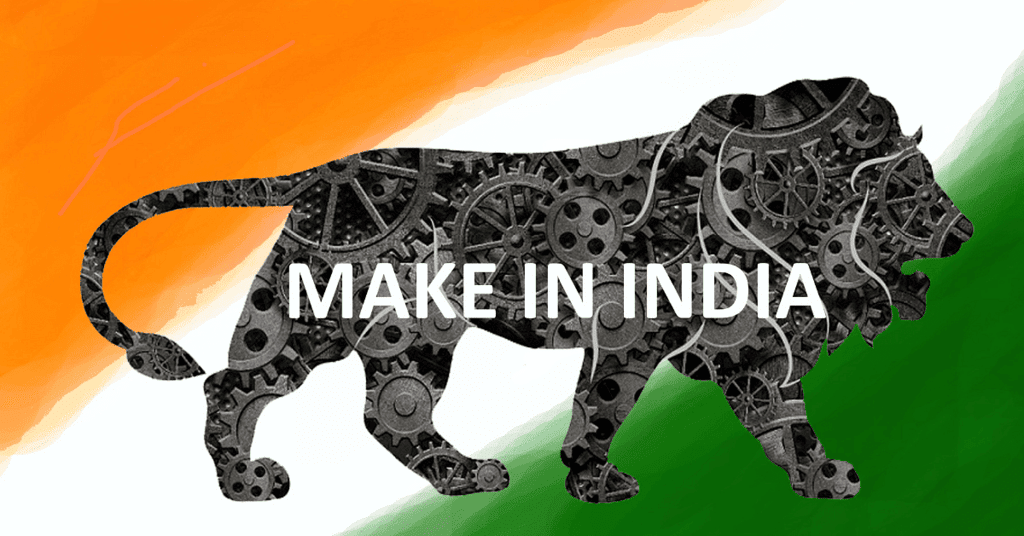
- Financial Stress on DISCOMs: Default on bank loans by financially stressed DISCOMs poses risks to the banking sector and the overall economy.
AT&C Losses: Aggregate Technical and Commercial (AT&C) losses capture both technical and commercial losses in the network, providing a true indicator of total losses.
 Aggregate Technical and Commercial (AT&C)
Aggregate Technical and Commercial (AT&C)- Historical Perspective: AT&C losses became prominent as they address technical losses due to inadequate investments, resulting in system overloads and inefficiencies.
Technical Losses Causes:
- Inadequate Investments: High technical losses result from insufficient investments over the years, leading to unplanned extensions of distribution lines and overloading of system elements.
- System Overload: Overloaded transformers and conductors contribute to technical losses.
- Reactive Power Support: Lack of adequate reactive power support further exacerbates technical losses.
Reducing Power Losses
- Metering Issues: Sometimes, the devices measuring electricity use don't work well, leading to inaccurate readings.
- Theft: People might steal electricity by tampering with meters or connecting to power lines illegally.
- Pilferage: Unauthorized use of electricity, like bypassing meters, contributes to losses.
How to Fix These Issues:
- Better Meters: We need modern meters that accurately measure electricity use.
- Keep Track: Regular checks and audits can help find problems and hold people accountable.
- Improve Billing: Making billing and payment processes more efficient helps recover the money for the power used.
- Hold People Accountable: Those in charge of managing power distribution need to be responsible for their areas.
Government Plans:
UDAY (Ujjwal DISCOM Assurance Yojana):

- Goal: Make power distribution companies healthier financially and operationally.
- Purpose: Reduce financial burdens, improve efficiency, and lower power losses.
RDSS (Revamped Distribution Sector Scheme):
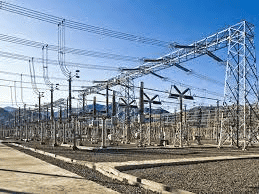
- Introduced in 2021-22 to reform power distribution.
- Provides money to power companies based on their performance in meeting specific targets.
RDSS Goals:
- Cut Power Losses: Aiming to significantly reduce overall power losses.
- Balance Money In and Out: Working to make sure the cost of supplying power equals the money collected.
- Build Better Systems: Helping power companies become more modern and efficient.
- Provide Good, Reliable, and Affordable Power: Making sure people get quality power that they can afford.
Money Matters:
- Total Budget: The government has set aside ₹3.03 lakh crores for this effort.
- Government Support: The government is giving a lot of money, around ₹97.6 thousand crores, to make these changes happen.
Aviation
India is becoming one of the world's fastest-growing aviation markets. Domestic air travel in India doubled from 61 million in 2013-14 to 162.10 million in 2022-23. This means more people are flying within the country every year. Indian Aviation Industry
Indian Aviation Industry
Government Initiatives:
- Domestic Sector Opening: The government slowly allowed more flights when the pandemic's first wave eased.
- Air Transport Bubbles: Special agreements were made with specific countries for air travel.
- Air India Disinvestment: The government sold part of Air India to private investors.
- Airport Modernization: Efforts to upgrade and expand airports are ongoing.
- Regional Connectivity (UDAN): A scheme to connect smaller cities, making air travel more accessible.
- MRO Incentives: Supporting maintenance, repair, and overhaul operations in aviation.
Challenges in Airport Infrastructure:
- Upgrading airports is a concern, including building new terminals and improving services.
- New automation systems are being installed to enhance air navigation.
Addressing Challenges - Recommendations:
- Rationalizing VAT: States should adjust taxes on aviation fuel to support airlines.
- Foreign Investment: Allow international airlines to invest in Indian airlines.
- Direct Fuel Import: Airlines should be allowed to directly import fuel for their use.
- Turnaround Plans: Airlines should prepare plans to improve their financial situation.
- Fair Pricing: Review the pricing structure to cover operational costs and avoid unfair pricing.
Potential for Growth:
- The aviation sector has huge potential due to the increasing middle class, population growth, tourism, higher incomes, and better aviation infrastructure.
- Government schemes like UDAN are improving connectivity, especially in smaller cities.
UDAN Scheme Benefits:
- More than one crore passengers have benefited from UDAN, focusing on connecting Tier-2 and 3 cities.
- The government approved 21 new airports across the country.

The government is working to make air travel more accessible and efficient, overcoming challenges and ensuring growth in the aviation sector.
Telecom
Telecom is one of the three basic infrastructures in any economy. In India, it plays a crucial role in implementing various government schemes, especially those based on the JAM (Jan Dhan Aadhar Mobile) trinity.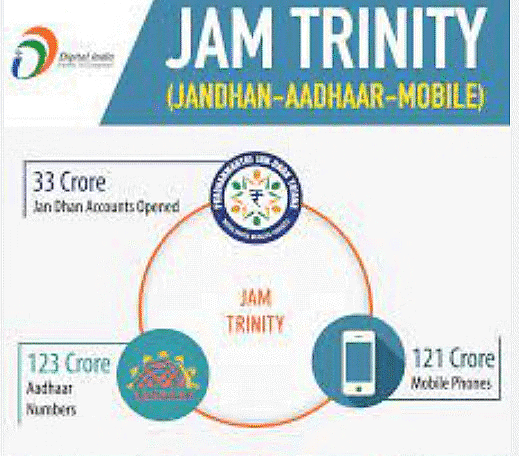 JAM (Jan Dhan Aadhar Mobile)
JAM (Jan Dhan Aadhar Mobile)
The government, under the Digital India Campaign, focuses on providing broadband access to all citizens, addressing the digital divide.
Growth and Status:
- As of November 2022, India had 117 crore telephone subscribers.
- Over 97% of subscribers use wireless connections (114.3 crore).
- Approximately 83.7 crore people have internet connections as of June 2022.
- The overall tele-density in India is 84.8%, varying across states.
- Some regions, like Delhi, Mumbai, Kolkata, etc., have a tele-density above 100%.
Recent Policy Steps:
- 4G Saturation Drive: Special efforts to bring 4G mobile services to villages without coverage.
 Evolution in various generations
Evolution in various generations - North-Eastern Region Connectivity: Implementing the Comprehensive Telecom Development Plan (CTDP) to provide mobile connectivity in uncovered villages.
- Island Connectivity: A separate CTDP launched to connect islands to the mainland using submarine optical fiber.
- Telegraph Infrastructure Deployment: Easier deployment for faster 5G rollout through Indian Telegraph Right of Way Amendment Rules 2022.
- National Frequency Allocation Plan (NFAP) 2022: Launched to regulate frequency bands for various services like cellular mobile, Wi-fi, broadcasting, navigation, and wireless communications.
Government's Vision:
- These steps aim to bridge the digital divide, making telecom services more accessible and user-friendly across the country.
- The focus is on aligning spectrum usage efficiently with emerging technologies, supporting the growth of telecom in India.
Digital Infrastructure
Digital Infrastructure in India: Traditional infrastructure has long played a vital role in socio-economic development. However, the significance of digital infrastructure has grown, especially during the Covid-19 pandemic, where restrictions on physical interactions led to increased reliance on digital alternatives. India's Digital Infrastructure
India's Digital Infrastructure
Digital India Program:
- The ongoing Digital India program by the Government aims to transform India into a digitally empowered society and knowledge economy.
- The vision includes making digital infrastructure a core utility for every citizen.
Focus Areas:
- High-Speed Internet: Ensuring high-speed internet as a core utility for delivering services to citizens.
- Digital Identity: Establishing a unique digital identity for individuals.
- Citizen Participation: Enabling citizens to participate in digital and financial spaces.
- Shareable Private Space: Allowing citizens to digitally store and share documents securely.
- Cybersecurity: Ensuring a safe and secure cyberspace.
- Digital Journey:
- India's digital journey began with Aadhaar, facilitating doorstep service delivery.
- The introduction of UPI (Unified Payment Interface) strengthened the digital payment infrastructure.
- Various initiatives like UMANG, Co-WIN, e-RUPI, TReDS, Account Aggregators, ONDC, Bhashini, Web 3.0 based OCEN, etc., contribute to building a robust digital story.
- Regulatory Challenges:
- Emerging technologies bring new regulatory challenges.
- The government, committed to keeping pace with digital developments, is working on establishing an effective regulatory framework.
- Ongoing Journey:
- The digital transformation in India's public infrastructure is ongoing.
- With untapped potential, the government continues to explore new avenues and technologies.
Digital infrastructure is becoming increasingly crucial for India's socio-economic development, offering convenience, accessibility, and security in the digital space.
Semiconductor Industry
Global Supply Chains and Semiconductor Shortage: Initially, global supply chains appeared normal until the weaknesses were exposed by the Covid-19 pandemic. The semiconductor (chip) shortage, a crucial component in electronics, especially impacted the automotive industry worldwide. Top 10 Semiconductor industries in India
Top 10 Semiconductor industries in India
- Policy Initiatives:
- Many countries, including the USA, recognized the need to diversify their semiconductor supply chains.
- In 2022, the USA announced a significant policy initiative with a government fund of US$ 280 billion over the next 10 years, aiming to boost chip manufacturing capacity.
- US Dependence and Initiative:
- Despite producing 10% of the world's semiconductors, the USA heavily depends on imports, primarily from East Asia.
- The US initiative focuses on research and development, allocating 71% of the fund to this purpose.
- India's Semiconductor Development:
- India, too, prioritizes semiconductor development for self-reliance and global participation in the value chain.
- A comprehensive program, the Programme for Development of Semiconductors and Display Manufacturing Ecosystem, was approved by the Indian Government in September 2022.
- Financial Support and Incentives:
- The program involves an outlay of ₹76,000 crore (approx. US$ 10 billion).
- The government offers 50% financial support for the capital expenditure of investing firms over the next 6 years.
- The Design Linked-Incentive (DLI) scheme nurtures semiconductor design by domestic companies, leveraging intellectual property (IP).
- Despite having 20% of the world's semiconductor design engineers, India has a minimal share in IP.
- PLI Scheme for IT Hardware: India introduced the PLI scheme for IT hardware known as the Scheme for Promotion of Manufacturing of Electronic Components and Semiconductors (SPECS).
- Global and Domestic Response: By early 2023, various global and domestic initiatives are underway to strengthen semiconductor manufacturing capabilities, recognizing their critical role in modern industries.
Mining Industry
Minerals and Economic Development: Minerals are crucial for development, gaining more significance in the era of electric vehicles and the fourth industrial revolution. Despite India's vast mineral reserves, legislative and procedural hurdles hindered its mining potential.
- Structural Reforms (2005):
- Shifted from the "first-come-first-served" method to auctioning mineral concessions for transparency.
- Established the NMET (National Mineral Exploration Trust) to boost exploration.
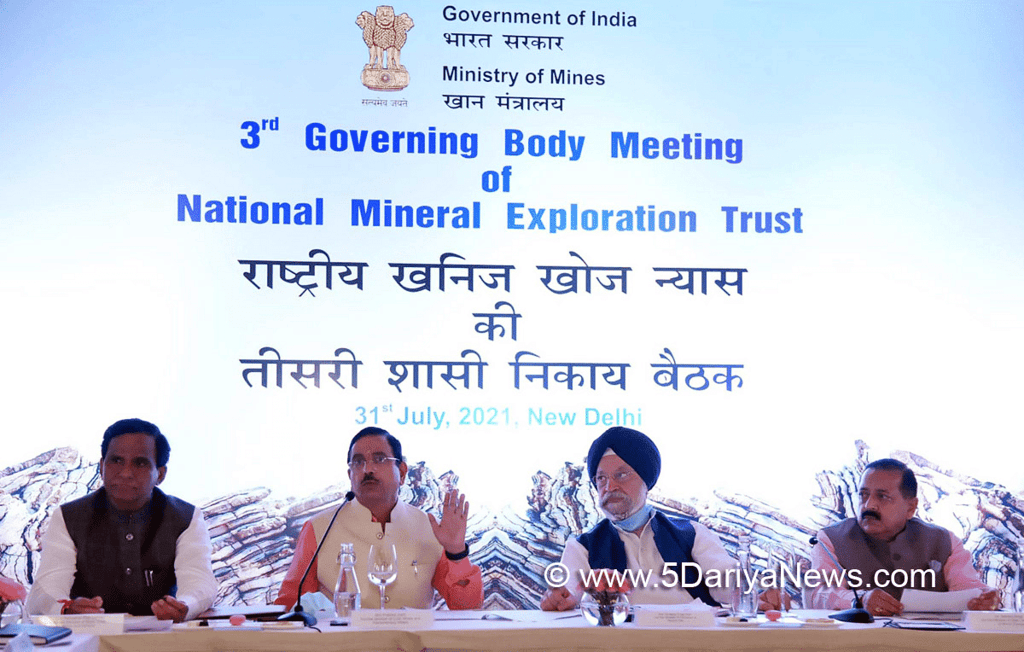 NMET (National Mineral Exploration Trust)
NMET (National Mineral Exploration Trust) - Introduced a uniform lease period of 50 years.
- Removed the need for prior approval from the Central Government for mineral concessions (excluding atomic minerals, coal, and lignite).
- Implemented DMF (District Mineral Foundation) for the welfare of people and areas affected by mining.
- Further Reforms (2020-21):
- Amended the MMDR Act to transfer statutory clearances to the new licensee for proven-field mines, eliminating delays in production.
- Introduced a seamless composite regime for exploration, mining, and production.
- Announced the auctioning of 500 mining blocks transparently.
- Facilitated joint auctions for bauxite and coal mineral blocks.
- Removed the distinction between captive and non-captive mines.
- Introduced a Mineral Index for different minerals.
- Rationalized stamp duty and approved a Schedule of Charges (SoC) for exploration projects funded by NMET.
- Initiated the AIMS (Aluminium Import Monitoring System) and CIMS (Copper Import Monitoring System) to monitor imports, aiding policy intervention.

- Goals and Impact:
- Aims to boost growth, employment, and technology infusion in the mining sector.
- Introduces structural reforms for seamless operations and efficient policy implementation.
- Encourages open and transparent auctions, reducing delays and boosting production in the mining industry.
Renewable Energy
India holds immense potential in renewable energy, with an estimated capacity of 8,96,602 MW, covering solar, wind, small hydro, and biomass power. This clean energy not only contributes to the main power grid but also serves various needs in remote areas, such as lighting and water pumping. Total renewable installed capacity in India as of September 2014
Total renewable installed capacity in India as of September 2014
As of October 2022, India has made significant strides in renewable energy, with a total capacity exceeding 105.10 GW, excluding large hydro projects. The renewable sector contributes about 38.27% to the total electric installed capacity and approximately 26.96% to electric energy generation. However, the variability in factors like sunshine and wind influences the actual utilization of this installed capacity.
The Indian government has implemented several initiatives to boost renewable energy:
- Solar Rooftop and Parks: Encouraging grid-connected rooftop systems and establishing solar parks with a target capacity of 22,000 MW.
- NSM Solar Projects: Planning to set up 15,000 MW of grid-connected solar PV power projects.
- Solar Pumps: Aiming to install one lakh solar pumps for agricultural and drinking water needs.
- Solar Cities: Approving projects to develop 56 solar cities.
- Surya Mitra Scheme: Launched to train 50,000 personnel in solar energy-related skills.
Recent policy initiatives, up to April 2023, include:
- Offshore Wind Energy Policy: Focusing on utilizing the vast coastline for offshore wind energy.
- Priority Sector Inclusion: Providing financial support with bank loans for renewable energy projects.
- Foreign Investment: Allowing up to 74% automatic approval for foreign equity participation in joint ventures and 100% FDI.
- Green Energy Corridor (GEC) Projects: Facilitating the evacuation of renewable power and enhancing the grid for future needs.
- National Hydrogen Mission: Aiming to position hydrogen as a top clean fuel for the future.
- PM-KUSUM Scheme: Targeting a reduction in the farm sector's carbon footprint by promoting solar power for energy and water needs.
These efforts underscore India's commitment to cleaner energy and sustainable development, empowering rural and remote areas and establishing the country as a significant player in the global renewable energy landscape.
PM Gati Shakti
The PM Gati Shakti, launched in October 2021, is like a digital brain that connects 16 government ministries responsible for infrastructure, like roads, railways, and power. Its main job is to plan and execute projects to make it easier and cheaper to move things around the country. PM Gati Shakti
PM Gati Shakti
This plan focuses on six important things:
- Comprehensiveness: It includes all the current and planned projects in one place, so everyone knows what's happening.
- Prioritization: Different departments can decide which projects are more important by working together.
- Optimization: It helps find the best ways to do things, saving both time and money.
- Synchronization: It ensures that different departments work together smoothly, avoiding delays caused by working in separate groups.
- Analytical: It uses technology to gather and analyze data from different sources, making it easier to understand what's going on.
- Dynamic: It allows real-time tracking of projects using satellite images, helping to see progress as it happens.
The main goal is to improve how things move across the country, making transportation more efficient and reducing the time and money spent on logistics. Currently, logistics costs in India are higher than in developed countries, affecting our ability to compete globally. PM Gati Shakti aims to change that by bringing everyone together and using technology to make things work better.
Recent Challenges
- The infrastructure sector in India faced significant challenges despite government efforts to involve the private sector through the Public-Private Partnership (PPP) model during the period of reforms.

- Several factors contributed to the challenges in the sector. Project delays, causing high-cost overruns, improved initially but increased again to 494 delays by November 2022 due to the pandemic and global factors.
- Delays in land acquisition posed a significant issue, but improvements were seen with the withdrawal of the Land Act of 2015 and the introduction of an effective "land pooling" policy. Some states, like Andhra Pradesh, had surplus land in the pooling arrangement.
- Scarcity of funds due to longer gestation periods was addressed partially through Infrastructure Investment Trusts (IITs), 5/25 Refinancing scheme, and debt restructuring. An insolvency procedure was initiated under the Bankruptcy and Insolvency Act since late 2017-18.
- Weaknesses in existing PPP models, which were initially designed for the road sector, were addressed by introducing the new Hybrid Annuity Model (HAM) for other infrastructure sectors by late 2017.
- Economic challenges, including the global financial crisis of 2008 and a state of "policy paralysis" in the domestic economy since 2010, contributed to the slowdown. A "twin balance sheet crisis" emerged by late 2016-17, with public sector banks struggling with high non-performing assets (NPAs) and private corporations facing challenges in borrowing and investing due to losses.
- The government has been taking initiatives to address these challenges and improve the performance of the infrastructure sector.
Way Forward
To maintain growth momentum in a fast-moving world, India needs to develop its industry and infrastructure. The scope for Industry 4.0 (the 4th Industrial Revolution) and Next Generation infrastructure is enormous, presenting an opportunity that India cannot afford to miss. Industry 4.0 involves automation, while next-generation infrastructure combines physical infrastructure with technologies like the Internet of Things (IoT) and automation to maximize overall efficiency.
For the upcoming year 2022-24, several factors provide both positive and negative indications for the sector:
Positive Factors:
- Declining international commodity prices can reduce input costs.
- Increasing capacity utilization in the manufacturing sector, boosted by schemes like Production-Linked Incentives (PLI), indicates prospects for higher investment by companies.
- Growing credit growth contributes to the positive outlook.
Negative Factors:
- Slowing exports due to the global economic slowdown.
- Potential disruptions in the supply chain due to international factors such as volatility in global commodity prices, the resurgence of Covid-19 in China, and geopolitical issues.
- A rebound in demand for commodities due to normalization in China, potentially reversing recent declines in commodity prices.
Despite these uncertainties, India's industrial output is expected to continue growing steadily. This growth is supported by resilient domestic demand, increased foreign fund inflows (above pre-pandemic levels), structural reforms, and measures enhancing the ease of doing business.
Recent Developments in Industry and Infrastructure (2024–2025)
1. Industrial Policies and Reforms
- Production-Linked Incentive (PLI) Schemes: Expanded to 14 sectors, including green hydrogen and aerospace. By 2025, PLI has driven significant growth in electronics (e.g., 30% of Apple’s iPhone production in India) and pharmaceuticals. New incentives announced in 2024–25 for emerging sectors.
- Foreign Direct Investment (FDI): Further liberalization in 2024, with 100% FDI allowed in space and defense sectors. Insurance FDI cap raised to 74% in 2021, now fully implemented.
- Business Reforms Action Plan (BRAP): 2024–25 BRAP emphasizes state-level ease of doing business, replacing the discontinued World Bank Doing Business index. Focus on digital clearances and labor reforms.
- National Industrial Corridor Development Program (NICDP): 12 corridors operational, including Delhi-Mumbai and Amritsar-Kolkata, boosting regional development and employment.
- Gati Shakti National Master Plan (2021): Integrated multi-modal connectivity projects, with 2024–25 updates prioritizing greenfield smart cities and logistics hubs.
- Startup India: Over 100,000 startups and 100+ unicorns by 2025. New tax exemptions introduced in 2024 to support innovation.
2. Infrastructure Development
- Roads and Highways: Bharatmala Phase II underway, with India’s National Highway network exceeding 1.5 lakh km by 2025. Green highways with solar panels introduced.
- Railways: Eastern and Western Dedicated Freight Corridors (DFCs) fully operational. Amrit Bharat Station Scheme redeveloping 1,300+ stations with sustainable designs.
- Ports and Sagarmala: Port capacity nearing 3,000 MTPA, with green ports and coastal shipping emphasized in 2024–25.
- Aviation: UDAN expanded, with 150+ operational airports. India targets 300 airports by 2030.
- Digital Infrastructure: 5G rollout completed in urban areas; 6G trials began in 2024. Data center policies strengthened to support AI and cloud computing.
- Urban Infrastructure: Smart Cities Mission and AMRUT 2.0 focus on sustainable urban mobility and water security. National Urban Digital Mission (NUDM) enhances data-driven governance.
3. Energy Sector
- Renewable Energy: India surpassed 200 GW capacity, targeting 500 GW by 2030. New solar parks, offshore wind projects, and PLI for solar PV introduced in 2024–25.
- Green Hydrogen Mission: Launched in 2023, aiming for 5 MMT production by 2030. NTPC’s $21 billion green hydrogen hub in Andhra Pradesh announced in 2025.
- Nuclear Energy: 10 new reactors planned by 2032, with small modular reactors (SMRs) prioritized in 2024–25. Pink and blue hydrogen use nuclear energy.
- Power Distribution: Revamped Distribution Sector Scheme (RDSS) targets smart metering and loss reduction by 2025, replacing UDAY.
- Energy Storage and EVs: FAME III (2024) boosts EV charging infrastructure. Battery storage policies support renewable integration.
4. Public Sector Enterprises (PSEs) and Disinvestment
- Disinvestment: Strategic sales (e.g., IDBI Bank) ongoing. National Monetization Pipeline (NMP) targets ₹6 lakh crore by 2025, monetizing roads, railways, and stadiums.
- Space and Defense PSUs: IN-SPACe facilitates private space startups. HAL’s exports (e.g., ALH helicopters) grew in 2024–25.
5. MSMEs and Labor Reforms
- MSME Support: PM Vishwakarma Scheme (2023) aids artisans. Udyam portal and GeM enhancements boost digital procurement in 2024–25.
- Labor Reforms: Four Labor Codes (2020) fully implemented by 2025, streamlining compliance and worker rights.
6. Critical and Emerging Technologies
- India Semiconductor Mission: Three semiconductor plants approved in 2024, with production starting in 2025.
- AI and Quantum Computing: National Quantum Mission and AI Mission launched in 2023, with 2024–25 funding for R&D.
- Global Supply Chain Shifts: India leverages China+1 strategy, attracting firms like Apple and Tesla.
7. Climate Finance and Sustainability
- Green Bonds and ESG Frameworks: Green bond issuances doubled in 2024–25, funding renewable and infra projects.
- Sustainable Infrastructure: Solar-powered railway stations and green highways align with net-zero goals.
8. Budget and Economic Survey 2024–25
- Budget Highlights: ₹2 lakh crore for employment-linked incentives, ₹1.5 lakh crore for agriculture, and ₹11.11 lakh crore for infrastructure.
- Economic Survey: Notes low solar component production (e.g., polysilicon) and emphasizes green hydrogen and semiconductors.
|
173 videos|487 docs|159 tests
|
FAQs on Ramesh Singh Summary: Industry & Infrastructure- 3 - Indian Economy for UPSC CSE
| 1. What is the PLI Scheme and how does it impact the performance of CPSEs? |  |
| 2. How does Industry 4.0 influence the digital infrastructure sector? |  |
| 3. How has Covid-19 impacted the power sector and what industrial reforms have been introduced as a response? |  |
| 4. What are the key challenges faced by the aviation industry in the context of semiconductor industry developments? |  |
| 5. How has the telecom sector adapted to the changing landscape of digital infrastructure and what opportunities does it present for growth? |  |
















